Abstract
This paper presents a new scheme of a cost-effective tunable millimeter-wave (MMW) frequency synthesizer based on an ultra-wideband electro-optic frequency comb. The architecture for the quasi-tunable millimeter-wave frequency synthesizer mainly consists of a compact ultra-wide flat electro-optic frequency comb and a multi-tone frequency generator, which only includes a quantum dot mode-locked laser, a LiNbO dual-driving Mach–Zehnder modulator (DD-MZM) and Uni-traveling-carrier photodiode (UTC-PD). MMW signals generated with a quasi-tunable frequency are experimentally demonstrated. The difference in power is obtained for the different frequencies. The linewidth of the quasi-tunable frequency signals is less than 273 Hz. In addition, the single side band (SSB) phase noise of the 25, 37.5, 50 and 75 GHz is measured as −115, −106, −102 and −95 dBc/Hz at an offset of 1 kHz, respectively. The proposed frequency synthesizer has ultra-low phase noise, quasi-tunable frequency and simple structure. The research results of the frequency synthesizer are applied for 5G+ transmission with radio wave working at K-band and V-band. The flexible, compact and robust MMW frequency synthesizer is suitable for the future of ultra-high capacity 5G+ communication.
1. Introduction
The increased bandwidth demand for high capacity and ultra-low latency services of fifth generation mobile networks (5G) has promoted the exploration of high-capacity radio-over-fiber (ROF) system to accommodate a wide range of novel applications with diverse requirements, which will be prospective for 5G/5G+ wireless access [1], internet of things, disaster emergency communication and military applications. ROF possesses wide bandwidths provided by the millimeter-wave (MMW) frequency resource [2] and integrates the advantages of wireless and optical systems. MMW frequencies can provide orders of magnitude greater bandwidths between 30 and 300 GHz for ROF [3] for 5G/5G+ applications covering the frequency range of the K-band (18 to 26.5 GHz) and the V-band (50 to 75 GHz).
ROF systems are generally centralized radio access networks for 5G using the wavelength-division multiplexing (WDM) technique to offer ultra-wideband wireless delivery with low interference by combining data transmitted on different wavelengths based on many individual lasers, which are not intrinsically phase-locked. Benefiting from the superiority of stable frequency spacing and wideband phase coherence of the optical comb lines and optical frequency comb (OFC) has emerged as a potential substitute for hundreds of individual lasers in WDM systems [4], due to the reduced energy consumption and size of the 5G/5G+ transmitter. The generation of various frequencies within the comb lines also allows for high-fidelity frequency transfer to different frequency domains, such as the microwave, MMW and terahertz domains [5].
The latest advances in the MMW generation based on OFC mainly include micro resonator-based Kerr frequency combs [6], high nonlinearity fiber combs [7], electro-optic combs (EO-combs) [8] and mode-locked laser combs [9]. Due to their simple optical architecture and offering wide band and flexible tuning of the spectrum interval [10], electro-optic frequency combs based on external modulation have been revisited in recent years primarily in the context of arbitrary optical waveform generation, high bit-rate optical communication and MMW photonics synthesizers [11].
These generators based on electro-optic modulators (EOMs) have some advantages, including their frequency interval and tunable central-frequency, which are important for applications in telecommunication and spectroscopy [12]. In [13], a novel method to generate a MMW signal was proposed, which employed a uniform fiber Bragg grating based acousto-optic tunable filter (FBG-AOTF) and a DD-MZM with frequency multiplication factors of 2 and 4, paying for a large power penalty. To achieve higher frequency multiplication factors, external modulation techniques employ cascaded electro-optic modulator (EOM) to produce more harmonically related optical modes. In [14], a frequency 16-tupling technique was demonstrated using four cascaded MZMs.
With the proper adjustment of the DC bias, the amplitude and phases of the RF local oscillators, an MMW signal with a frequency of 16 times the input RF signals is demonstrated. Unfortunately this method is limited to big RF power and a big power penalty. According to the intrinsic photoelectric characteristics of the EOM, over-driving of conventional electro-optic modulators is provided for EO-comb generation [15].
However, optical comb lines suffer from inherent phase instabilities and big power deviations, leading to excess multiplication of MMW phase noise, which limits their usage in 5G+ transmission [16]. A range of EO-combs can be explored to generate directly or through upconversion of MMW signals [17] but suffer from high phase noise and are not as spectrally pure as photonic based sources [18,19].
Recently, MMW signal generation using a quantum dot (QD) laser has been greatly promoted, mainly due to the superior characteristics of nanostructure lasers constructed with progressive QD active regions [20,21,22,23,24]. Repetition rates of 29.8 and 55.6 GHz with pulse duration of 855 and 707 fs were obtained, respectively [21]. By regulating the gain current and the reversed-biased voltage, the generated signals with adjustable frequency and the minimum pulse width of 3.7 ps have been demonstrated, with an adjustable frequency range of 300 MHz [20].
A phase noise as low as 105 dBc/Hz at an offset frequency of 100 kHz was achieved by using a quantum dash mode-locked laser. In [25], they demonstrated intracavity MMW generation within THz quantum cascade lasers (QCLs) over the unprecedented range of 25 to 500 GHz. This will open up the possibility of compact, low noise MMW generation using mode-locked THz frequency combs. In [5], they launched a coherent comb with 8.9 GHz spacing with a span of almost 200 lines in the C-Band (1530 to 1565 nm), with only 20 dBm of microwave modulation power. Extremely spectrally pure microwaves at 32 GHz achieved a phase noise < −120 dBc/Hz, although the carrier frequency is limited to harmonics of the repetition frequency of the comb [26].
In [27], they proposed a scheme of MMW signal generation with a 20 nm bandwidth using a two section InAs/InP Quantum dot mode-locked laser (QDMLL), with an optical linewidth of less than 101 kHz. However, there are inadequate reports proving the MMW signal generated to have excellent low phase noise properties by these methods [16,28,29,30,31].
In this paper, we propose and experimentally demonstrate a novel tunable multi-tone MMW photonic generation based on ultra-wide electro-optic frequency combs for high-capacity 5G+ signal transmission. The architecture of the scheme mainly uses a flexible ultra-wide broadband electro-optic frequency comb generator, UTC-PD and tunable frequency filter. In particular, an electro-optic frequency comb is generated by only using a passive QDMLL and a DD-MZM, but not many optical devices, such as fiber Bragg grating (FBG), semiconductor optical amplifier (SOA) and erbium doped optical fiber amplifier (EDFA). Mode locking enhances the broadband spectrum, spectrum flatness, equal frequency spacing and low phase noise.
Compared to the reported MMW generators mentioned above [18,19,20], the proposed method is very flexible and compact, as it does not use polarization controllers, optical filters, SOA and phase-locked loop, which greatly improves the efficiency and robustness of the system.
2. Materials and Methods
2.1. EO-Combs with a DD-MZM
To generate wideband EO-combs with a DD-MZM, we apply an asymmetric drive condition. The electro-optic transfer function [16] of an DD-MZM is represented as a function of an applied modulation voltage , which is given by
where is the voltage applied to generate a phase drift of between both arms as the half-wave voltage [28]. In practice, is diverse between DC and RF. is the insert loss. The phase drift resulting from an internal path length differences between the two arms of the MZM is expressed as . Usually, as the other modulators have independent electrodes for RF and DC, the modulation voltage and the constant bias voltage provided at the DC electrode are independent of each other. provided at the RF electrode is the time-varying modulation voltage. If the is supposed as a sinusoidal voltage, the modulation voltage can be represented as
where expresses a stochastic process that shows the phase fluctuations interpreted as a parasitic phase modulation with the RF signal. and V are, respectively, the angular frequency and the voltage amplitude of the RF driving signal.hus, the electro-optic transfer function [29] of the DD-MZM can be extended to
Supposing the optical carrier is linearly polarized and aligned to the electro-optic modulator’s polarization state axis, the electric field expression of input optical wave is in scalar type as
where is the phase of the light. If , the output power is the largest; and if , the light fields in the two branches are eliminated by interfering with each other. The output power is the smallest, which is zero in the ideal case. Now, assuming the input optical carrier is supported to the input port of the DD-MZM practically, the mathematical expression of the output optical signal modulated is given by
where
Clearly, diverse spectral comb lines will be generated due to the nonlinearity of the electro-optic converse function, which determined on the static phase offset caused by the bias voltage and on the magnitude of the signal modulated.In order to well comprehend the modulated spectrum, the Bessel functions is used in mathematical Equation (5), which is given by
According to Equation (6) [28], the two RF signals with reversal phase drive the DD-MZM, i.e., ; thus, , and a flat OFC can be generated.
2.2. Schematic Architecture
The schematic architecture of the tunable multi-tone 5G+ MMW frequency synthesizer based on the EO-combs is shown in Figure 1. It consists of QDMLL, a commercial LiNbO DD-MZM with the of V, an RF signal generator, an UTC-PD with a beating broadband of 110 GHz, a power divider and tunable frequency filter. The emission spectrum directly from the QDMLL is in the C-band wavelength range from 1520 nm to 1558 nm, using a GaAs/InP Fabry–Pérot laser cavity.
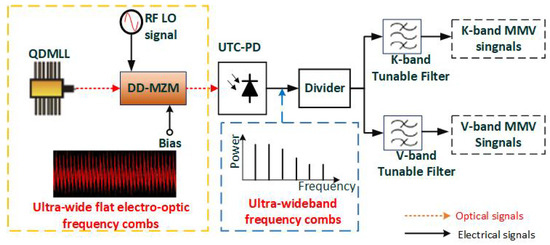
Figure 1.
Schematic architecture of the tunable multi-tone 5G+ MMW frequency synthesizer using ultra-wide broadband electro-optic frequency combs.
The output spectrum of the GaAs/InP QDMLL has many attractive useful characteristics [29], such as ultra-low relative intensity noise (RIN) (less than −160 dB/Hz), small optical linewidth (less than 158 KHz) and a large optical signal-to-noise ratio (OSNR) (up to 72 dB), etc. In the proposed architecture of tunable multi-tone MMW generators, the output spectrum of the QDMLL is modulated by the DD-MZM, which is driven by two opposite-phase sinusoidal wave RF signals.
The bias voltage is used to set the operating point of the DD-MZM, important for improving the flatness of the optical comb lines generated. Compared to the reported MMW generators, this scheme does not use polarization controllers, optical phase lock loops and optical filters. As a result, it is considered to be more compact and flexible, which makes it simple to generate tunable and low-phase noise MMW signals [32].
3. Results
3.1. Flexibility
The performance of the tunable MMW frequency synthesizer is researched by using high performance test instruments, such as complex optical spectrum analyzer (OSA), tunable RF filter, a 110 GHz UTC-PD and an electrical spectrum analyzer (ESA).The ultra-wide broadband electro-optic frequency combs are experimentally generated from a QDMLL modulated by a DD-MZM, shown in Figure 2. In experiments, a GaAs/InP QD Fabry–Pérot QDMLL is used to emit optical beams with a 75 GHz frequency spacing in the C-band.
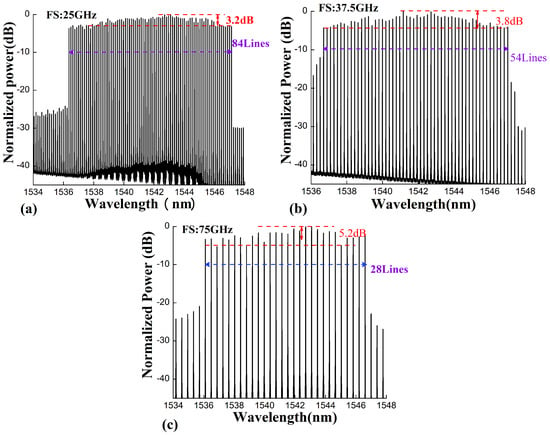
Figure 2.
The measured maximum power deviation within the 10 dB spectrum of OFC with frequency spacing of (a) 25, (b) 37.5 and (c) 75 GHz. FS: Frequency spacing.
The QD laser is mounted stably with the temperature of 18 C, with a threshold current of around 25 mA. The average output power of the QD laser is about 15 dBm, with the injection current fixed at 180 mA. A 11 nm bandwidth OFCs with 84, 54 and 28 comb lines at frequency spacing of 25, 37.5 and 75 GHz and 84 optical comb lines are experimentally created, respectively, shown in Figure 2a–c. A tailored OFC with frequency spacing of 25 GHz is generated from the DD-MZM driven by a sinusoidal RF signal (the total RF power is about 20 dBm, which is much lower than that in [12]).
By adjusting the bias voltage of the DD-MZM, the maximum power shift of 3.2 dB over 84 lines is created with an equal frequency spacing of 25 GHz for the wavelength range from 1536 to 1547 nm. Similarly, the maximum power shift of 3.8 and 5.2 dB over 58 and 28 modes are created with an equal frequency spacing of 37.5 and 75 GHz, respectively. Unlike other electro-optic frequency comb methods, such as methods proposed in [9,11], the ultra-wide broadband OFC generated by this scheme has greater flexibility.
The QD mode-locked laser used is passively mode locked laser, which has a relative intensity noise (RIN) of about 150–160 dB/Hz, which is much better than commercial QW DFB lasers. Compared with the reported MMW Optical Frequency synthesizer, this scheme has not used many optical devices, such as fiber Bragg grating filters, polarization controllers and optical phase lock loops. Therefore, this system structure is very simple and small sized, promoting the system robustness and stability.
3.2. Flatness
We measured and comparatively analyzed different frequency spacings of OFCs, as shown in Figure 3. The OSNR test was performed in the optical resolution bandwidth of 100 MHz. Figure 2, the number of flat comb lines is related to the maximum power shift with different frequency spacing. It is shown that the flatness of the 25 GHz OFC is better than the 37.5 and 75 GHz OFC by adjusting the modulation depth applied on the DD-MZM. The optical signal to noise ratio (OSNR) of the optical modes is also investigated, and the OSNR of the frequency spacings at 25, 37.5 and 75 GHz within the 10 dB bandwidth are shown in Figure 3. The results show that the OSNR at 25 and 37.5 GHz frequency spacing is significantly lower than that at 75 GHz frequency spacing.
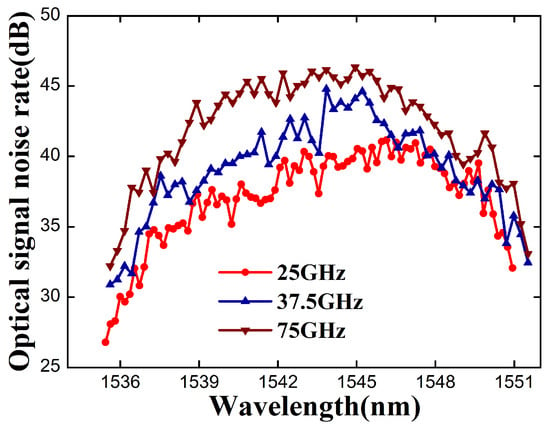
Figure 3.
OSNR comparison of the different frequency spacing of OFCs, frequency spacing of 25 GHz (red), 37.5 GHz (blue) and 75 GHz (brown).
Apparently, the comb lines generated are not flat in broadband, which is partially due to the characteristics of the DD-MZM. Restricted by the characteristics of commercial devices, the power deviation of the comb lines cannot be eliminated.
3.3. Stability
Tunable MMW signals are generated from ultra-wide broadband electro-optic frequency combs with different frequency spacing. The tunable MMW signal generation is based on the RF carrier created from two adjacent lines of the different OFCs. The K-band and V-band MMW signals generated based on EO-combs at different frequency intervals were measured and are shown in Figure 4a,b, respectively. The spectrum properties of the MMW signals generated were tested by the ESA with a 200 Hz resolution bandwidth (RBW).
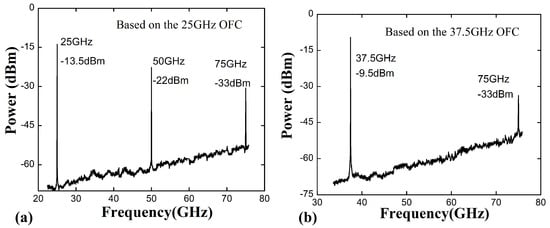
Figure 4.
Electrical spectra of the K-band and V-band at different intervals as measured from the MMW frequency synthesizer. (a) MMW generated from the 25 GHz OFC; (b) MMW generated from the 37.5 GHz OFC.
In Figure 4, the powers of the frequency at 25, 37.5, 50 and 75 GHz are about −13.5, −9.5, −22 and −33 dBm, respectively. The power of MMW signal generated from 37.5 OFC is larger than that from 25 GHz OFC. The experiment shows linewidths of 250 Hz, 259 Hz, 265 Hz and 273 Hz is for the 25, 37.5, 50 and 75 GHz, respectively. The results prove that the OFC generated by the EOM and QD laser had excellent properties, such as great stability and ultra-low phase noise. These measurements show that the OFC generated by the QD laser has extremely low phase noise and high stability [16].
In addition, the phase noise is measured by a UTC-PD. We measure the single side-band (SSB) phase noise of the MMW generated by 25 and 37.5 GHz OFC as shown in Figure 5. The SSB phase noises of the 25, 37.5, 50 and 75 GHz are −115 dBc/Hz, −106 dBc/Hz, −102 dBc/Hz and −95 dBc/Hz at an offset of 1 kHz, respectively. It is clear that the SSB phase noise of the 25 GHz was the lowest compared to the other frequencies before the offset of 1 kHz, while the SSB phase noise of 75 GHz was the highest. The low phase noise of the MMW signals is due to the low power deviation and the low phase noise of the quantum dot laser. Beyond the offset of 100 kHz, the phase noise approaches a noise floor without any fluctuating peaks [20]. The experimental results show that the MMW frequency synthesizer based on this structure has high stability.
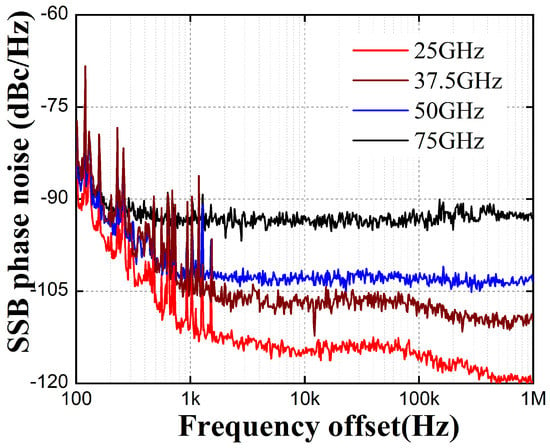
Figure 5.
Single sideband (SSB) phase noise of the comparisons of the 25, 37.5, 50 and 75 GHz generated from different OFCs.
4. Conclusions
The OSNR was obtained with an optical resolution bandwidth of 100 MHz. We proposed a simple and flexible design scheme of a high capacity tunable 5G+ MMW synthesizer based on ultra-wideband electro-optical OFCs. The architecture is compact and integrated and mainly consists of a monolithic Fabry–Pérot QD laser and a conventional MZM and UTC-PD. The QD laser demonstrated excellent properties of equal frequency spacing, which greatly reduced the system complexity and device noise.
In addition, the comb lines produced by QD lasers were very flexible and tunable and were modulated by a DD-MZM. The EOM-OFCs involved an 11 nm spectrum with a 10 dB bandwidth. The frequency interval OFCs of 75, 37.5 and 25 GHz had 28, 58 and 84 flat spectral lines, respectively. The OSNR of the comb lines was more than 37 dB. The SSB phase noise of the MMW signals generated was −106 dBc/Hz and −115 dBc/Hz at 1 kHz offset for 37.5 GHz and 25 GHz. The results show that the linewidth of the MMW frequency synthesized based on the combs was less than 273 Hz.
The MMW signal was generated by the optical comb lines beating each other in the UTC-PD. The MMW signal frequency depended on the frequency interval of the comb lines, and the power was related to the power of the beating lines. Thus, the difference of power was obtained for the different frequencies, related to the beating frequency generation mechanism.
In this work, a flexible MMW frequency synthesizer was demonstrated. If the DD-MZM is adequately modulated by adequate power and appropriate bias voltage, tunable frequency synthesis from 7.5 to 75 GHz can be achieved by this scheme, involving from the K-band to V-band MMW. Experiments showed that the technology is simple in generating high-quality MMW and suitable for high-capacity 5G/5G+ communication transmission. Small size and ultra-wide broadband OFCs are extensively applied in 5G wireless access, satellite communications and intelligent wireless techniques.
Author Contributions
Conceptualization, L.L., Y.L. and X.Z.; methodology, L.L.; software, L.L.; validation, L.L., Y.L., X.-Z.G.; formal analysis, L.L.; investigation, L.L.; resources, L.L.; data curation, L.L.; writing—original draft preparation, L.L.; writing—review and editing, Y.L. and X.-Z.G.; visualization, L.L.; supervision, L.L.; project administration, L.L.; funding acquisition, L.L. All authors have read and agreed to the published version of the manuscript.
Funding
This research was funded by in part by the Zhejiang Provincial Natural Science Foundation of China grant number LQ18F010008, the Humanities and Social Science Research Youth Foundation of the Ministry of Education grant number 19YJC880053 and the Zhejiang Philosophy and Social Science Planning Project grant number 19NDJC103YB.
Conflicts of Interest
The authors declare no conflict of interest. The funders had no role in the design of the study; in the collection, analyses, or interpretation of data; in the writing of the manuscript, or in the decision to publish the results.
References
- Zeb, K.; Zhang, X.; Lu, Z. High Capacity Mode Division Multiplexing Based MIMO Enabled All-Optical Analog Millimeter-Wave Over Fiber Fronthaul Architecture for 5G and Beyond. IEEE Access 2019, 7, 89522–89533. [Google Scholar] [CrossRef]
- Chen, N.; Okada, M. Toward 6G Internet of Things and the Convergence with RoF System. IEEE Internet Things J. 2021, 8, 8719–8733. [Google Scholar] [CrossRef]
- Salgals, T.; Ostrovskis, A.; Ipatovs, A.; Bobrovs, V.; Spolitis, S. Hybrid ARoF-WDM PON Infrastructure for 5G Millimeter-wave Interface and Broadband Internet Service. In Proceedings of the IEEE 2019 Photonics Electromagnetics Research Symposium-Fall (PIERS-Fall), Xiamen, China, 17–20 December 2019; pp. 2161–2168. [Google Scholar] [CrossRef]
- Piccardo, M.; Tamagnone, M.; Schwarz, B.; Chevalier, P.; Rubin, N.A.; Wang, Y.; Wang, C.A.; Connors, M.K.; McNulty, D.; Belyanin, A.; et al. Radio frequency transmitter based on a laser frequency comb. Proc. Natl. Acad. Sci. USA 2019, 116, 9181–9185. [Google Scholar] [CrossRef] [PubMed] [Green Version]
- Fortier, T.; Kirchner, M.; Taylor, J.; Bergquist, J.; Jiang, Y.; Ludlow, A.; Oates, C.; Rosenband, T.; Diddams, S.; Quinlan, F.; et al. Generation of Ultrastable microwaves via optical frequency division. Nat. Photonics 2011, 5, 425–429. [Google Scholar] [CrossRef] [Green Version]
- Liang, W.; Eliyahu, D.; Ilchenko, V.S.; Savchenkov, A.A.; Matsko, A.B.; Seidel, D.; Maleki, L. High spectral purity Kerr frequency comb radio frequency photonic oscillator. Nat. Commun. 2015, 6, 7957. [Google Scholar] [CrossRef] [PubMed]
- Pistore, V.; Nong, H.; Vigneron, P.B.; Garrasi, K.; Houver, S.; Li, L.; Giles Davies, A.; Linfield, E.H.; Tignon, J.; Mangeney, J.; et al. Millimeter wave photonics with terahertz semiconductor lasers. Nat. Commun. 2021, 12, 1427. [Google Scholar] [CrossRef]
- Fortier, T.; Baumann, E. 20 years of developments in optical frequency comb technology and applications. Commun. Phys. 2019, 2, 153. [Google Scholar] [CrossRef]
- Wake, D.; Lima, C.R.; Davies, P.A. Optical generation of millimeter-wave signals for fiber-radio systems using a dual-mode DFB semiconductor laser. IEEE Trans. Microw. Theory Tech. 1995, 43, 2270–2276. [Google Scholar] [CrossRef]
- Torres-Company, V.; Schroder, J.; Fulop, A.; Mazur, M.; Lundberg, L.; Helgason, O.B.; Karlsson, M.; Andrekson, P.A. Laser Frequency Combs for Coherent Optical Communications. J. Light. Technol. 2019, 37, 1663–1670. [Google Scholar] [CrossRef] [Green Version]
- Spencer, D.T.; Drake, T.; Briles, T.C.; Stone, J.; Sinclair, L.C.; Fredrick, C.; Li, Q.; Westly, D.; Ilic, B.R.; Bluestone, A.; et al. An optical-frequency synthesizer using integrated photonics. Nature 2018, 557, 81–85. [Google Scholar] [CrossRef]
- Rueda, A.; Sedlmeir, F.; Kumari, M.; Leuchs, G.; Schwefel, H.G.L. Resonant electro-optic frequency comb. Nature 2019, 568, 378–381. [Google Scholar] [CrossRef]
- Kuse, N.; Fermann, M.E. Electro-optic comb based real time ultra-high sensitivity phase noise measurement system for high frequency microwaves. Sci. Rep. 2017, 7, 2847. [Google Scholar] [CrossRef]
- Baskaran, M.; Prabakaran, R. Optical millimeter wave signal generation with frequency 16-tupling using cascaded MZMs and no optical filtering for radio over fiber system. J. Eur. Opt.-Soc.-Rapid Publ. 2018, 14, 13. [Google Scholar] [CrossRef] [Green Version]
- Torres-Company, V.; Weiner, A.M. Optical frequency comb technology for ultra-broadband radio-frequency photonics. Laser Photonics Rev. 2014, 8, 368–393. [Google Scholar] [CrossRef] [Green Version]
- Liu, G.; Lu, Z.; Liu, J.; Mao, Y.; Vachon, M.; Song, C.; Barrios, P.; Poole, P.J. Passively mode-locked quantum dash laser with an aggregate 5376 Tbit/s PAM-4 transmission capacity. Opt. Express 2020, 28, 4587. [Google Scholar] [CrossRef] [PubMed]
- Vujicic, V.; Calo, C.; Watts, R.; Lelarge, F.; Browning, C.; Merghem, K.; Martinez, A.; Ramdane, A.; Barry, L.P. Quantum Dash Mode-Locked Lasers for Data Centre Applications. IEEE J. Sel. Top. Quantum Electron. 2015, 21, 53–60. [Google Scholar] [CrossRef]
- Niccolò Rinaldi, M.S. Silicon-Germanium Heterojunction Bipolar Transistors for mm-Wave Systems: Technology, Modeling and Circuit Applications; Illustrated Edition; River Publishers: Dresden, Germany, 2018. [Google Scholar]
- Aghasi, H.; Naghavi, S.M.H.; Tavakoli Taba, M.; Aseeri, M.A.; Cathelin, A.; Afshari, E. Terahertz electronics: Application of wave propagation and nonlinear processes. Appl. Phys. Rev. 2020, 7, 021302. [Google Scholar] [CrossRef]
- Marin-Palomo, P.; Kemal, J.N.; Trocha, P.; Wolf, S.; Merghem, K.; Lelarge, F.; Ramdane, A.; Freude, W.; Randel, S.; Koos, C. Comb-based WDM transmission at 10 Tbit/s using a DC-driven quantum-dash mode-locked laser diode. Opt. Express 2019, 27, 31110. [Google Scholar] [CrossRef] [PubMed]
- Li, J.; Yi, X.; Lee, H.; Diddams, S.A.; Vahala, K.J. Electro-optical frequency division and stable microwave synthesis. Science 2014, 345, 309–313. [Google Scholar] [CrossRef] [Green Version]
- Kemal, J.N.; Marin-Palomo, P.; Merghem, K.; Aubin, G.; Calo, C.; Brenot, R.; Lelarge, F.; Ramdane, A.; Randel, S.; Freude, W.; et al. 32QAM WDM transmission using a quantum-dash passively mode-locked laser with resonant feedback. In Proceedings of the Optical Fiber Communications Conference and Exhibition (OFC 2017), Los Angeles, CA, USA, 19–23 March 2017; IEEE: San Diego, CA, USA, 2017; pp. 1–3. [Google Scholar]
- Fujita, K.; Hayashi, S.; Ito, A.; Hitaka, M.; Dougakiuchi, T. Sub-terahertz and terahertz generation in long-wavelength quantum cascade lasers. Nanophotonics 2019, 8, 238. [Google Scholar] [CrossRef]
- Rafailov, E.U.; Cataluna, M.A.; Sibbett, W.; Il’inskaya, N.D.; Zadiranov, Y.M.; Zhukov, A.E.; Ustinov, V.M.; Livshits, D.A.; Kovsh, A.R.; Ledentsov, N.N. High-power picosecond and femtosecond pulse generation from a two-section mode-locked quantum-dot laser. Appl. Phys. Lett. 2005, 87, 081107. [Google Scholar] [CrossRef]
- Diddams, S.A.; Vahala, K.; Udem, T. Optical frequency combs: Coherently uniting the electromagnetic spectrum. Science 2020, 369, eaay3676. [Google Scholar] [CrossRef]
- Xie, X.; Bouchand, R.; Nicolodi, D.; Giunta, M.; Hänsel, W.; Lezius, M.; Joshi, A.; Datta, S.; Alexandre, C.; Lours, M.; et al. Photonic microwave signals with zeptosecond-level absolute timing noise. Nat. Photonics 2017, 11, 44–47. [Google Scholar] [CrossRef]
- Zeb, K.; Lu, Z.; Liu, J.; Mao, Y.; Liu, G.; Poole, P.J.; Rahim, M.; Pakulski, G.; Barrios, P.; Jiang, W.; et al. InAs/InP quantum dash buried heterostructure mode-locked laser for high capacity fiber-wireless integrated 5G new radio fronthaul systems. Opt. Express 2021, 29, 16164. [Google Scholar] [CrossRef]
- Lundberg, L.; Mazur, M.; Mirani, A.; Foo, B.; Schröder, J.; Torres-Company, V.; Karlsson, M.; Andrekson, P.A. Phase-coherent lightwave communications with frequency combs. Nat. Commun. 2020, 11, 201. [Google Scholar] [CrossRef] [PubMed]
- Mezzapesa, F.P.; Pistore, V.; Garrasi, K.; Li, L.; Davies, A.G.; Linfield, E.H.; Dhillon, S.; Vitiello, M.S. Tunable and compact dispersion compensation of broadband THz quantum cascade laser frequency combs. Opt. Express 2019, 27, 20231. [Google Scholar] [CrossRef] [PubMed]
- Wang, F.; Nong, H.; Fobbe, T.; Pistore, V.; Houver, S.; Markmann, S.; Jukam, N.; Amanti, M.; Sirtori, C.; Moumdji, S.; et al. Short Terahertz Pulse Generation from a Dispersion Compensated Modelocked Semiconductor Laser. Laser Photonics Rev. 2017, 11, 1700013. [Google Scholar] [CrossRef] [Green Version]
- Garrasi, K.; Mezzapesa, F.P.; Salemi, L.; Li, L.; Consolino, L.; Bartalini, S.; De Natale, P.; Davies, A.G.; Linfield, E.H.; Vitiello, M.S. High dynamic range, heterogeneous, terahertz quantum cascade lasers featuring thermally-tunable frequency comb operation over a broad current range. arXiv 2019, arXiv:1901.08851. [Google Scholar] [CrossRef]
- Hu, H.; Oxenløwe, L.K. Chip-based optical frequency combs for high-capacity optical communications. Nanophotonics 2021, 10, 561. [Google Scholar] [CrossRef]
Publisher’s Note: MDPI stays neutral with regard to jurisdictional claims in published maps and institutional affiliations. |
© 2021 by the authors. Licensee MDPI, Basel, Switzerland. This article is an open access article distributed under the terms and conditions of the Creative Commons Attribution (CC BY) license (https://creativecommons.org/licenses/by/4.0/).